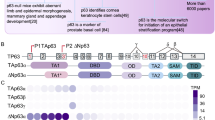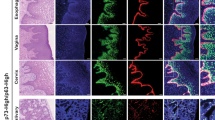Abstract
Mammary epithelial regeneration implies the existence of cellular progenitors with retained replicative capacity, prolonged lifespan and developmental potency. Evidence exists that ΔN-p63 isoforms preserve these features by modulating p53 activity in basal epithelia. ΔN-p63 mRNA levels decline at the onset of differentiation suggesting that its transcriptional regulation may contribute to the initiation of differentiation. To study transcriptional regulation of ΔN-p63, a 10.3 kbp fragment containing the ΔN-p63 promoter was isolated. We report here that ΔN-p63 is a positive and negative transcriptional target of p53 and ΔN-p63-α, respectively. Disruption of p53 activity or expression abolishes the expression of ΔN-p63-α. This regulation is mediated by a p53-binding element sufficient to confer these activities to a heterologous promoter. Chromatin immune-precipitation indicates that, in asynchronously growing cells, p53 occupies this element. In response to DNA damage, ΔN-p63-α is recruited to this element as transcription of ΔN-p63 declines. Disruption of ΔN-p63-α expression had differential effects on the transcriptional regulation of several p53-target genes. These findings indicate that p53 contributes to the preservation of basal epithelia by driving the expression of ΔN-p63 isoforms. These studies also suggest that in response to genotoxic stress, ΔN-p63-α mediates the silencing of its own promoter thereby altering the pattern of p53-target gene expression.
This is a preview of subscription content, access via your institution
Access options
Subscribe to this journal
Receive 50 print issues and online access
$259.00 per year
only $5.18 per issue
Buy this article
- Purchase on Springer Link
- Instant access to full article PDF
Prices may be subject to local taxes which are calculated during checkout





Similar content being viewed by others
References
Barker N, Huls G, Korinek V and Clevers H . (1999). Am. J. Pathol., 154, 29–35.
Brummelkamp TR, Bernards R and Agami R . (2002). Science, 296, 550–553.
Costanzo A, Merlo P, Pediconi N, Fulco M, Sartorelli V, Cole PA, Fontemaggi G, Fanciulli M, Schiltz L, Blandino G, Balsano C and Levrero M . (2002). Mol. Cell, 9, 175–186.
DiRenzo J, Signoretti S, Nakamura N, Rivera-Gonzalez R, Sellers W, Loda M and Brown M . (2002). Cancer Res., 62, 89–98.
Dohn M, Zhang S and Chen X . (2001). Oncogene, 20, 3193–3205.
Flores ER, Tsai KY, Crowley D, Sengupta, S, Yang A, McKeon F and Jacks T . (2002). Nature, 416, 560–564.
Hall PA, Campbell SJ, O'Neill M, Royston DJ, Nylander K, Carey FA and Kernohan NM . (2000). Carcinogenesis, 21, 153–160.
Hennighausen L and Robinson GW . (1998). Genes Dev., 12, 449–455.
Hovey RC, Trott JF and Vonderhaar BK . (2002). J. Mamm. Gland Biol. Neoplasia, 7, 17–38.
Irwin MS and Kaelin WG . (2001). Cell Growth Differ., 12, 337–349.
Jerry DJ, Dickinson ES, Roberts AL and Said TK . (2002). J. Dairy Sci., 85, 1103–1110.
Jerry DJ, Pinkas J, Kuperwasser C, Dickinson ES and Naber SP . (1999). J. Mamm. Gland Biol. Neoplasia, 4, 177–181.
Kaelin Jr WG . (1999). Oncogene, 18, 7701–7705.
Korinek V, Barker N, Moerer P, van Donselaar E, Huls G, Peters PJ and Clevers H . (1998). Nat. Genet., 19, 379–383.
Li P, Barraclough R, Fernig DG, Smith JA and Rudland PS . (1998). Int. J. Exp. Pathol., 79, 193–206.
Liefer KM, Koster MI, Wang XJ, Yang A, McKeon F and Roop DR . (2000). Cancer Res., 60, 4016–4020.
Marin MC and Kaelin Jr WG . (2000). Biochim. Biophys. Acta, 1470, M93–M100.
Masso-Welch PA, Darcy KM, Stangle-Castor NC and Ip MM . (2000). J. Mamm. Gland Biol. Neoplasia, 5, 165–185.
Mills AA, Zheng B, Wang XJ, Vogel H, Roop DR and Bradley A . (1999). Nature, 398, 708–713.
Nakagawa T, Takahashi M, Ozaki T, Watanabe Ki K, Todo S, Mizuguchi H, Hayakawa T and Nakagawara A . (2002). Mol. Cell Biol., 22, 2575–2585.
Nylander K, Vojtesek B, Nenutil R, Lindgren B, Roos G, Zhanxiang W, Sjostrom B, Dahlqvist A and Coates PJ . (2002). J. Pathol., 198, 417–427.
Parsa R, Yang A, McKeon F and Green H . (1999). J. Invest. Dermatol., 113, 1099–1105.
Patturajan M, Nomoto S, Sommer M, Fomenkov A, Hibi K, Zangen R, Poliak N, Califano J, Trink B, Ratovitski E and Sidransky D . (2002). Cancer Cell, 1, 369–379.
Pellegrini G, Dellambra E, Golisano O, Martinelli E, Fantozzi I, Bondanza S, Ponzin D, McKeon F and De Luca M . (2001). Proc. Natl. Acad. Sci. USA, 98, 3156–3161.
Roose J, Huls G, van Beest M, Moerer P, van der Horn K, Goldschmeding R, Logtenberg T and Clevers H . (1999). Science, 285, 1923–1926.
Sasaki Y, Ishida S, Morimoto I, Yamashita T, Kojima T, Kihara C, Tanaka T, Imai K, Nakamura Y and Tokino T . (2002). J. Biol. Chem., 277, 719–724.
Shaulian E, Zauberman A, Ginsberg D and Oren M . (1992). Mol. Cell Biol., 12, 5581–5592.
Signoretti S, Waltregny D, Dilks J, Isaac B, Lin D, Garraway L, Yang A, Montironi R, McKeon F and Loda M . (2000). Am. J. Pathol., 157, 1769–1775.
Smith GH and Chepko G . (2001). Microsc. Res. Tech., 52, 190–203.
Suliman Y, Opitz OG, Avadhani A, Burns TC, El-Deiry W, Wong DT and Rustgi AK . (2001). Cancer Res., 61, 6467–6473.
van Bokhoven H and Brunner HG . (2002). Am. J. Hum. Genet., 71, 1–13.
van Bokhoven H and McKeon F . (2002). Trends Mol. Med., 8, 133–139.
Westfall MD, Mays DJ, Sniezek JC and Pietenpol JA . (2003). Mol. Cell Biol., 23, 2264–2276.
Yang A, Kaghad M, Caput D and McKeon F . (2002). Trends Genet., 18, 90–95.
Yang A, Kaghad M, Wang Y, Gillett E, Fleming MD, Dotsch V, Andrews NC, Caput D and McKeon F . (1998). Mol. Cell, 2, 305–316.
Yang A and McKeon F . (2000). Nat. Rev. Mol. Cell Biol., 1, 199–207.
Yang A, Schweitzer R, Sun D, Kaghad M, Walker R, Bronson RT, Tabin C, Sharpe A, Caput D, Crum C and McKeon F . (1999). Nature, 398, 714–718.
Acknowledgements
This work is dedicated to the memory of Dr. Edward Bresnick; collaborator and friend. This work was supported by The General Motors Cancer Research Foundation Scholars Award Program, by the American Cancer Society Institutional Research Grant# IRG-82-003-18 and by the Hitchcock Foundation of Dartmouth Hitchcock Medical Center.
Author information
Authors and Affiliations
Corresponding author
Rights and permissions
About this article
Cite this article
Harmes, D., Bresnick, E., Lubin, E. et al. Positive and negative regulation of ΔN-p63 promoter activity by p53 and ΔN-p63-α contributes to differential regulation of p53 target genes. Oncogene 22, 7607–7616 (2003). https://doi.org/10.1038/sj.onc.1207129
Received:
Revised:
Accepted:
Published:
Issue Date:
DOI: https://doi.org/10.1038/sj.onc.1207129
Keywords
This article is cited by
-
Long-term expansion of directly reprogrammed keratinocyte-like cells and in vitro reconstitution of human skin
Journal of Biomedical Science (2020)
-
p53 controls the plasticity of mammary luminal progenitor cells downstream of Met signaling
Breast Cancer Research (2019)
-
Ribosomal protein S15a promotes tumor angiogenesis via enhancing Wnt/β-catenin-induced FGF18 expression in hepatocellular carcinoma
Oncogene (2018)
-
p63/MT1-MMP axis is required for in situ to invasive transition in basal-like breast cancer
Oncogene (2016)
-
The histone methyltransferase Setd8 acts in concert with c-Myc and is required to maintain skin
The EMBO Journal (2012)



